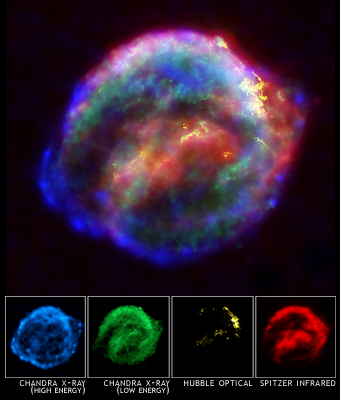
 |
| ACTIVITIES on Supernovae, Pulsars & Black Holes |
 Credit: NASA/ESA/JHU/Sankrit & Blair |
Tutorial and online lab. Take notes and do the exercises as you go. Click to open the virtual laboratory frameset at the bottom of the page and then choose "Labs for Semester 2" and then "Lab 3: Stellar Explosion Simulations" from the menu on the right. Print out the answer sheet .
|
|
In Hands-On Universe Book 3, do "Techniques for Finding a Supernova Unit" (p. 5-9) and "Discover a Supernova Unit" (p. 10-15). You will be using image processing software to manipulate actual images containing supernovae.
|
|
Make light curves for supernova data using Excel spreadsheets and use then to classify supernovas as Type Ia or Type II. | |
Use "raw" data processed from the Chandra satellite to turn boring numbers into a "super cool" picture of the Cas A supernova remnant. | |
Use ds9 image processing software to analyze real data from the Chandra X-ray Observatory. You will need to install the ds9 software first. You may wish to go through learning ds9 as well.
|
|
Information and activity book from Imagine the Universe!. A grade k-8 version of this book can be found through Starchild.
|
 |
|
It is the year 2070 and you and your crew of interstellar astronauts are prepared to take the first journey of humans beyond Pluto! Your mission is to test, firsthand, the predictions of Einstein's General Theory of Relativity. Specifically, your goal is a black hole some 10,000 light-years away. Because of its distance, the trip will be a multigenerational one. Your offspring, and theirs, and so on, will be trained in your task to complete the mission. (alternate version with extra help, formula sheet)
|
| ASSESSMENT ACTIVITIES for Stellar Evolution |
|
A webquest to assist students in acquiring a basic understanding and appreciation for the cosmic cycles of formation and destruction - and their connection to planet Earth. |
|
Put slides in order and write a script showing the evolutionary sequence of stars.
Helpful links: |
   |